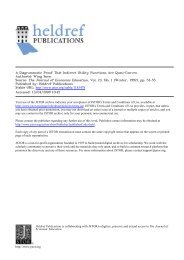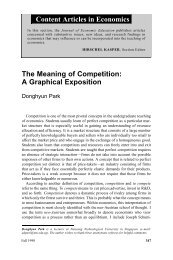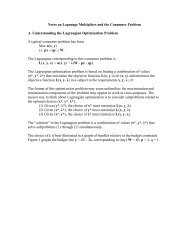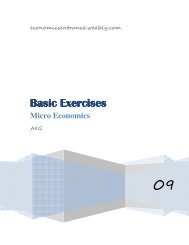HW 2 1. Consider a Chicken game where two players are driving ...
HW 2 1. Consider a Chicken game where two players are driving ...
HW 2 1. Consider a Chicken game where two players are driving ...
You also want an ePaper? Increase the reach of your titles
YUMPU automatically turns print PDFs into web optimized ePapers that Google loves.
<strong>HW</strong> 2<br />
<strong>1.</strong> <strong>Consider</strong> a <strong>Chicken</strong> <strong>game</strong> <strong>where</strong> <strong>two</strong> <strong>players</strong> <strong>are</strong> <strong>driving</strong> toward each other. Each player<br />
chooses between going straight, swerving to the left, and swerving to the right. The choices<br />
<strong>are</strong> made simultaneously. If one goes straight while the other swerves right or left, the one<br />
who goes straight gets a payoff of 3 while the other gets –<strong>1.</strong> If each swerves to his left, each<br />
gets 0. If each swerves to his right, again each gets 0. If both go straight, or if one swerves to<br />
his left while the other swerves to his right, then the cars crash and each gets the payoff –6.<br />
a) Show the payoff matrix for this <strong>game</strong>.<br />
b) Find all Nash equilibria in pure strategies.<br />
2. Two start ups <strong>are</strong> competing for leadership in a softw<strong>are</strong> market. The leader wins, and the<br />
other loses. Each firm can invest some x ∈ [0.001, 1] unit for research and development by<br />
paying cost of <br />
. If a firm invests x units and the other firm invests y units, the former wins<br />
<br />
with probability <br />
<br />
. Therefore, the payoff of the former start up will be − . All these <strong>are</strong><br />
<br />
common knowledge.<br />
a) Compute all pure strategy Nash equilibria.<br />
3. (A synergistic relationship) Two individuals <strong>are</strong> involved in a synergistic relationship. If both<br />
individuals devote more effort to the relationship, they <strong>are</strong> both better off. For any given<br />
effort of individual j, the return to individual i’s effort first increases, then decreases.<br />
Specifically, an effort level is a nonnegative number, and individual i’s preferences (for i = 1,<br />
2) <strong>are</strong> represented by the payoff function ai(c + aj − ai), <strong>where</strong> ai is i’s effort level, aj is the<br />
other individual’s effort level, and c > 0 is a constant.<br />
a) Model the above as a strategic <strong>game</strong>.<br />
b) Write the best response correspondence of player i.<br />
c) Solve for Nash Equilibrium.<br />
4. (A joint project) Two people <strong>are</strong> engaged in a joint project. If each person i puts in the effort<br />
xi, a nonnegative number equal to at most 1, which costs her c(xi), the outcome of the project<br />
is worth f (x1, x2). The worth of the project is split equally between the <strong>two</strong> people, regardless<br />
of their effort levels. Formulate this situation as a strategic <strong>game</strong>. Find the Nash equilibria of<br />
the <strong>game</strong> when (a) f (x1, x2) = 3x1x2 and c(xi) = for i = 1, 2, and (b) f (x1, x2) = 4x1x2 and<br />
c(xi) = xi for i = 1, 2. In each case, is there a pair of effort levels that yields both <strong>players</strong><br />
higher payoffs than the Nash equilibrium effort levels?<br />
5. (Cournot’s duopoly <strong>game</strong> with linear inverse demand and a fixed cost) Find the Nash<br />
equilibria of Cournot’s <strong>game</strong> when there <strong>are</strong> <strong>two</strong> firms, the inverse demand function is given<br />
by<br />
− ≤ <br />
= <br />
0 > <br />
<strong>where</strong> Q = q1 + q2<br />
and the cost function of each firm i ∈ {1, 2} is given by<br />
= + > 0<br />
0 = 0
<strong>where</strong> c ≥ 0, f > 0, and c < α. (Note that the fixed cost f affects only the firm’s decision of<br />
whether or not to operate; it does not affect the output a firm wishes to produce if it wishes to<br />
operate.)<br />
6. Definition (Strict Nash equilibrium) An action profile a* is a strict Nash equilibrium if for<br />
every player i we have ui(a*) > ui(ai, a-i*) for every action ai ≠ ai* of player i.<br />
a) Prove that a strict Nash Equilibrium is a Nash Equilibrium.<br />
b) <strong>Consider</strong> the following <strong>game</strong>:<br />
L R<br />
T 2, 1 1, 1<br />
M 1, 1 2, 0<br />
B 2, 0 1, 1<br />
Find the Nash Equilibria of the <strong>game</strong> above. How many of them <strong>are</strong> strict?<br />
c) <strong>Consider</strong> the following figure: Bi(aj) stands for the best response function of player i, the<br />
shaded <strong>are</strong>a of player 1’s best response function indicates that for a2 between and ,<br />
player 1 has a range of best responses. For example, all actions of player 1 from ∗∗ to<br />
∗∗∗ <strong>are</strong> best responses to the action ∗∗∗ of player 2.<br />
Find all the Nash Equilibria and the strict Nash equilibria of the <strong>game</strong> whose best<br />
response functions <strong>are</strong> given in the figure.




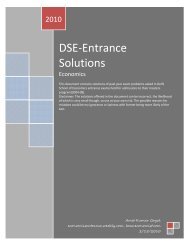
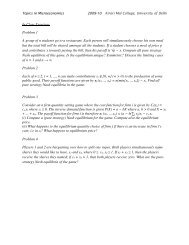


![2. Each of n ≥ 2, i = 1, ..., n can make contributions s i ∈ [0, w] (w ...](https://img.yumpu.com/19311695/1/190x245/2-each-of-n-2-i-1-n-can-make-contributions-s-i-0-w-w-.jpg?quality=85)
